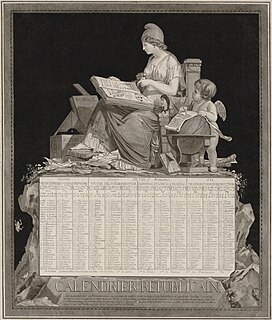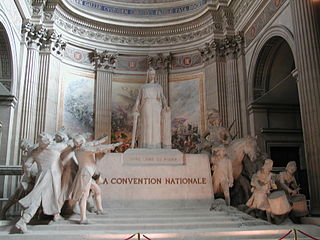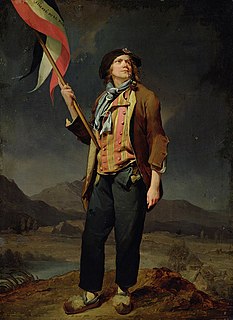 W
WIn the history of France, the First Republic, officially the French Republic, was founded on 22 September 1792 during the French Revolution. The First Republic lasted until the declaration of the First Empire in 1804 under Napoleon, although the form of the government changed several times. This period was characterized by the fall of the monarchy, the establishment of the National Convention and the Reign of Terror, the Thermidorian Reaction and the founding of the Directory, and, finally, the creation of the Consulate and Napoleon's rise to power.
 W
WThe French Republican calendar, also commonly called the French Revolutionary calendar, was a calendar created and implemented during the French Revolution, and used by the French government for about 12 years from late 1793 to 1805, and for 18 days by the Paris Commune in 1871. The revolutionary system was designed in part to remove all religious and royalist influences from the calendar, and was part of a larger attempt at decimalisation in France. It was used in government records in France and other areas under French rule, including Belgium, Luxembourg, and parts of the Netherlands, Germany, Switzerland, Malta, and Italy.
 W
WThe Directory was the governing five-member committee in the French First Republic from 2 November 1795 until 9 November 1799, when it was overthrown by Napoleon Bonaparte in the Coup of 18 Brumaire and replaced by the Consulate. It gave its name to the final four years of the French Revolution. Mainstream historiography also uses the term in reference to the period from the dissolution of the National Convention on 26 October 1795 to Napoleon's coup d’état.
 W
WThe first period of French rule in the Ionian Islands lasted from June 1797 to March 1799. Following the Fall of the Republic of Venice in May 1797, the Ionian Islands, a Venetian possession, were occupied by the French Republic. The French instituted a new, democratic regime and, following the Treaty of Campo Formio, annexed the islands to France, forming the three departments of Corcyre (Corfu), Ithaque (Ithaca) and Mer-Égée.
 W
WJemmape [ʒɛ.map] was a department of the First French Republic and of the First French Empire in present-day Belgium. It was named after the Battle of Jemappes, fought between the French and the Austrians in 1792 near the village of Jemappes, near Mons. Jemappes was spelled Jemmape, Jemmapes or Jemmappes at the time. Its territory corresponded more or less with that of the Belgian province of Hainaut. It was created on 1 October 1795, when the Austrian Netherlands and the Prince-Bishopric of Liège were officially annexed by the French Republic. Before annexation, its territory lay in the County of Hainaut, Tournai and the Tournaisis, the County of Namur (Charleroi) and the Bishopric of Liège (Thuin).
 W
WLys was a department of the French First Republic and French First Empire in present-day Belgium. It was named after the river Lys (Leie). It was created on 1 October 1795, when the Austrian Netherlands and the Prince-Bishopric of Liège were officially annexed by the French Republic. Prior to this annexation, its territory was part of the County of Flanders. Its Chef-lieu was Bruges.
 W
WThe National Convention was a parliament of the French Revolution, following the two-year National Constituent Assembly and the one-year Legislative Assembly. Created after the great insurrection of 10 August 1792, it was the first French government organized as a republic, abandoning the monarchy altogether. The Convention sat as a single-chamber assembly from 20 September 1792 to 26 October 1795.
 W
WPô [po] was a department of the French Consulate and of the First French Empire in present-day Italy. It was named after the river Po. It was formed in 1802, when the Subalpine Republic was directly annexed to France. Its capital was Turin.
 W
WThe Reign of Terror, commonly The Terror, was a period of the French Revolution when, following the creation of the First French Republic, a series of massacres and numerous public executions took place in response to revolutionary fervour, anticlerical sentiment, and spurious accusations of treason by Maximilien Robespierre and the Committee of Public Safety.
 W
WThe sans-culottes were the common people of the lower classes in late 18th-century France, a great many of whom became radical and militant partisans of the French Revolution in response to their poor quality of life under the Ancien Régime. The word sans-culotte, which is opposed to that of the aristocrat, seems to have been used for the first time on 28 February 1791 by officer Gauthier in a derogatory sense, speaking about a "sans-culottes army". The word came in vogue during the demonstration of 20 June 1792.